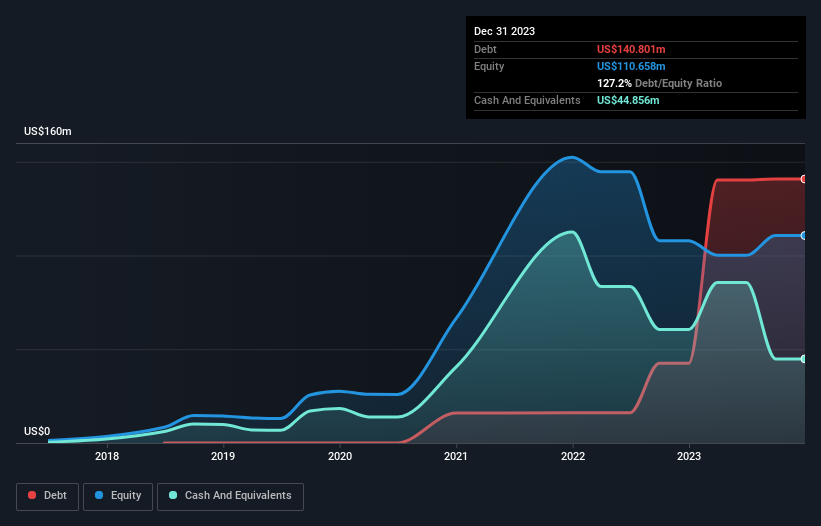Warren Buffett famously said, 'Volatility is far from synonymous with risk.' When we think about how risky a company is, we always like to look at its use of debt, since debt overload can lead to ruin. Importantly, Adriatic Metals PLC (ASX:ADT) does carry debt. But is this debt a concern to shareholders?
When Is Debt Dangerous?
Debt and other liabilities become risky for a business when it cannot easily fulfill those obligations, either with free cash flow or by raising capital at an attractive price. Ultimately, if the company can't fulfill its legal obligations to repay debt, shareholders could walk away with nothing. However, a more frequent (but still costly) occurrence is where a company must issue shares at bargain-basement prices, permanently diluting shareholders, just to shore up its balance sheet. Of course, plenty of companies use debt to fund growth, without any negative consequences. When we examine debt levels, we first consider both cash and debt levels, together.
Check out our latest analysis for Adriatic Metals
How Much Debt Does Adriatic Metals Carry?
You can click the graphic below for the historical numbers, but it shows that as of December 2023 Adriatic Metals had US$140.8m of debt, an increase on US$42.5m, over one year. On the flip side, it has US$44.9m in cash leading to net debt of about US$95.9m.

How Strong Is Adriatic Metals' Balance Sheet?
Zooming in on the latest balance sheet data, we can see that Adriatic Metals had liabilities of US$76.5m due within 12 months and liabilities of US$103.7m due beyond that. On the other hand, it had cash of US$44.9m and US$6.53m worth of receivables due within a year. So its liabilities total US$128.8m more than the combination of its cash and short-term receivables.
Given Adriatic Metals has a market capitalization of US$893.1m, it's hard to believe these liabilities pose much threat. But there are sufficient liabilities that we would certainly recommend shareholders continue to monitor the balance sheet, going forward. The balance sheet is clearly the area to focus on when you are analysing debt. But ultimately the future profitability of the business will decide if Adriatic Metals can strengthen its balance sheet over time. So if you want to see what the professionals think, you might find this free report on analyst profit forecasts to be interesting.
Given its lack of meaningful operating revenue, investors are probably hoping that Adriatic Metals finds some valuable resources, before it runs out of money.
Caveat Emptor
Importantly, Adriatic Metals had an earnings before interest and tax (EBIT) loss over the last year. To be specific the EBIT loss came in at US$21m. When we look at that and recall the liabilities on its balance sheet, relative to cash, it seems unwise to us for the company to have any debt. So we think its balance sheet is a little strained, though not beyond repair. Another cause for caution is that is bled US$124m in negative free cash flow over the last twelve months. So suffice it to say we consider the stock very risky. There's no doubt that we learn most about debt from the balance sheet. However, not all investment risk resides within the balance sheet - far from it. These risks can be hard to spot. Every company has them, and we've spotted 3 warning signs for Adriatic Metals (of which 1 is a bit concerning!) you should know about.
Of course, if you're the type of investor who prefers buying stocks without the burden of debt, then don't hesitate to discover our exclusive list of net cash growth stocks, today.
New: Manage All Your Stock Portfolios in One Place
We've created the ultimate portfolio companion for stock investors, and it's free.
• Connect an unlimited number of Portfolios and see your total in one currency
• Be alerted to new Warning Signs or Risks via email or mobile
• Track the Fair Value of your stocks
Have feedback on this article? Concerned about the content? Get in touch with us directly. Alternatively, email editorial-team (at) simplywallst.com.
This article by Simply Wall St is general in nature. We provide commentary based on historical data and analyst forecasts only using an unbiased methodology and our articles are not intended to be financial advice. It does not constitute a recommendation to buy or sell any stock, and does not take account of your objectives, or your financial situation. We aim to bring you long-term focused analysis driven by fundamental data. Note that our analysis may not factor in the latest price-sensitive company announcements or qualitative material. Simply Wall St has no position in any stocks mentioned.
About ASX:ADT
Adriatic Metals
Through its subsidiaries, engages in the exploration and development of precious and base metals.
Exceptional growth potential and slightly overvalued.
Similar Companies
Market Insights
Community Narratives




